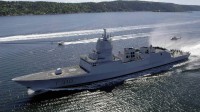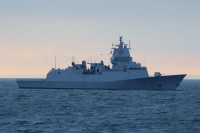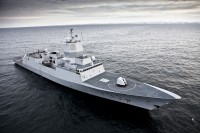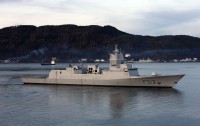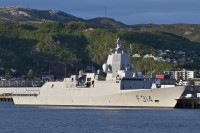Фрегати класу «Фрітьоф Нансен»
Основна інформація
Головні розміри
Машина
- 1 * BAZAN BRAVO 12V 4.5 MW diesel engines for cruising
- 1 * GE LM2500 21.5 MW gas turbine for high speed running
- MAAG gearboxes
- 2 * shafts driving controllable pitch propellers
- Bow Thruster Retractable (Electric) 1 MW Brunvoll
- Diesel generators 4 * MTU 396 Serie 12V 1250 KVA
Персонал
Бойові сили та засоби
- Lockheed Martin AN/SPY-1F 3D multifunction radar
- Reutech RSR 210N air/sea surveillance radar
- Sagem Vigy 20 Electro Optical Director
- Kongsberg MSI 2005F ASW combat system
- MRS 2000 hull mounted sonar
- Captas MK II V1 active/passive towed array sonar
- 2 * Mark 82 fire-control radar
- Condor CS-3701 ECM:/ESM: suite
- Terma DL-12T decoy launcher
- Loki torpedo countermeasure
- 1 or 2 * 8-cell Mk 41 VLS (32 * RIM-162 ESSM)
- 8 * Naval Strike Missile SSMs
- 4 * torpedo tubes for Sting Ray torpedoes
- Depth charges
- 1 * 76 mm OTO Melara Super Rapid gun
- 3 * 12.7 mm Browning M2HB machine guns Sea Protector
- 2 * LRAD Long Range Acoustic Device
- Capabilities for other weapons
- 1 * NH90 helicopter
The Fridtjof Nansen-class frigates are a class of frigates that are the main surface combatant units of the Royal Norwegian Navy. The ships are named after famous Norwegian explorers, with the lead ship of the class bearing the name of Fridtjof Nansen, the Norwegian scientist, explorer and humanitarian. Five ships were ordered from Spanish shipbuilder Bazan (now Navantia). The total projected cost for all five ships is 21 billion kr (about USD 2.54 billion). As of November 2018, four are in active service and one has sunk and been decommissioned.
The frigates were originally intended as a replacement for the aging Oslo-class frigates, with a primary focus on anti-submarine warfare (ASW). Eventually, the need for a robust anti-aircraft defense as well as the possibility of incorporating the Naval Strike Missile surface-to-surface missile produced by Norwegian company Kongsberg Defence & Aerospace led to a more multi-role design. The selection of Navantia as prime contractor led to the design being very similar to the Spanish Navy's Álvaro de Bazán-class frigates, including the incorporation of Lockheed Martin's AEGIS combat system.
The Fridtjof Nansen-class frigates are larger, and have more personnel and equipment than the Oslo-class frigates. Compared to the Oslo-class vessels, the new vessels are 35 meters longer, nine meters taller and two meters deeper below water. They are also five meters broader and have three times the water displacement of the old ships. The frigates also operates six new NFH NH90 helicopters, with the role as an extended «arm» of the frigates' ASW and ASuW capabilities.
On 26 February 2009, the Norwegian government decided to deploy Fridtjof Nansen to the Gulf of Aden, thereby participating in the ongoing Operation Atalanta, the European Union's counter-piracy campaign in Somalia. Fridtjof Nansen joined the campaign in August 2009.
Fridtjof Nansen's engagement in Operation Atalanta was carried out without a permanently stationed helicopter. Mainly due to delays in delivery of the new NH-90, the ship was equipped with two fast RHIBs for its onboard contingent of maritime special operations forces.
In December 2013 HNoMS Helge Ingstad and the Danish Absalon-class support ship HDMS Esbern Snare were sent to the Syrian port of Latakia to escort the Norwegian registered RoRo cargo ship Taiko and the Danish cargo ship Ark Futura, which transported Syrian chemical weapons to Italy where they were handed over to a United States Navy ship for destruction in international waters.
In 2018, while returning from participation in Exercise Trident Juncture, Helge Ingstad was involved in a collision with a Maltese-registered oil tanker, Sola TS, that severely damaged the frigate and caused a severe list that placed it in serious danger of sinking in spite of its position. The frigate was successfully beached to prevent it sinking and allow the crew to be evacuated. In the early hours of 13 November the vessel partially sank with only smaller sections of the superstructure remaining above water. The vessel was recovered but with the cost of repair prohibitive it has been decommissioned and will be scrapped.
Кораблі5
- Коментарі
 uk
uk en
en ru
ru
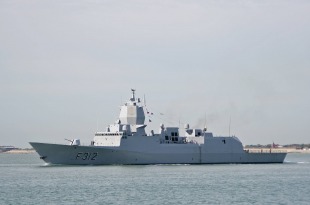

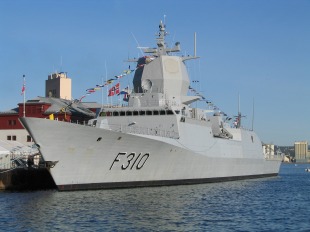



 Королівські військово-морські сили Норвегії
Королівські військово-морські сили Норвегії